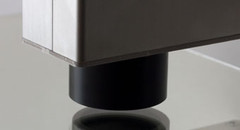Controlling conductivity of deposited layers is crucial for many applications. E. g. transparent conductive oxides are used for carrier transport in solar cells or for blocking infrared light in architectural glass. For metal layers or even carbon fibers, intrinsic conductivity can be used to analyze process specifics and deviations in-line. For carbon fibers, the correct lay-up can be checked even in multi-layer fabrics, missing bundles and wrinkles can be detected reliably. For thin metal deposition, grain sizes can affect the overall conductivity of the layer and if the conductivity is assumed as constant thicknesses of metal, layers can be controlled in-line.
To achieve fast contactless in-line analysis of conductivity properties, the method of choice is the eddy current measurement. The eddy current technique operates on a kHz basis, uses no moving parts, and does not contact the sample like 4 point-probes. These properties make it ideal for fast in-line process control.
Measurement principle
An excitation coil produces a magnetic field which penetrates the layer to be analysed. The conductive electrons within the layer are forced on circular paths and generate a magnetic field of their own which dampens the exciting field. A second coil, which either sits on the same side (reflective mode) or on the opposite side of the layer (transmission mode) detects the strength of the damping.
Conductivity measurements with EddYCus®
The LayTec EddYCus® system gauges the conductivity of thin layers without mechanical contact to the tested material. As fast, contact-less tool, EddYCus® is ideally suited for in-line measurements in all production lines where conductive layers are deposited. Find more on the product pages:
- EddYCus® TF inline
- EddYCus® TF lab
- EddYCus® TF map Hybrid
Products that apply this method
- EddyCus® TF inline
- EddyCus® TF lab
- EddyCus® TF map Hybrid


